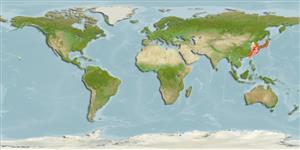Environment: milieu / climate zone / depth range / distribution range
Écologie
marin démersal; océanodrome (Ref. 51243); profondeur ? - 100 m. Subtropical; 46°N - 20°N, 116°E - 153°W
Northwest Pacific: Japan and the eastern Korean Peninsula to the Hawaiian Islands.
Taille / Poids / Âge
Maturity: Lm ? range ? - ? cm
Max length : 150 cm TL mâle / non sexé; (Ref. 9988); poids max. publié: 40.0 kg (Ref. 9988)
Épines dorsales (Total): 6 - 7; Rayons mous dorsaux (Total): 29-36; Épines anales 3; Rayons mous anaux: 17 - 22; Vertèbres: 24. Scutes absent. Compared to S. lalandi, the species' dorsoposterior corner of upper jaw is angular (versus rounded) and the pectoral and pelvic fins are almost equal in length (versus pectoral shorter than pelvic fin).
Adults exhibit shoaling habit (Ref. 9988). They feed on plankton. Juveniles are found among floating seaweeds (Ref. 12114, 12115). Collection of young is the basis for prosperous aquaculture in Japan. Raised in captivity and marketed fresh for sashimi (Ref. 9988).
Life cycle and mating behavior
Maturité | Reproduction | Frai | Œufs | Fécondité | Larves
Robins, C.R., R.M. Bailey, C.E. Bond, J.R. Brooker, E.A. Lachner, R.N. Lea and W.B. Scott, 1991. World fishes important to North Americans. Exclusive of species from the continental waters of the United States and Canada. Am. Fish. Soc. Spec. Publ. (21):243 p. (Ref. 4537)
Statut dans la liste rouge de l'IUCN (Ref. 130435)
Menace pour l'homme
Harmless
Utilisations par l'homme
Pêcheries: hautement commercial; Aquaculture: commercial; pêche sportive: oui
Outils
Articles particuliers
Télécharger en XML
Sources Internet
Estimates based on models
Phylogenetic diversity index (Ref.
82804): PD
50 = 0.5020 [Uniqueness, from 0.5 = low to 2.0 = high].
Bayesian length-weight: a=0.01413 (0.00618 - 0.03226), b=2.94 (2.74 - 3.14), in cm total length, based on LWR estimates for this (Sub)family-body shape (Ref.
93245).
Niveau trophique (Ref.
69278): 4.0 ±0.65 se; based on food items.
Generation time: 3.4 ( na - na) years. Estimated as median ln(3)/K based on 1
growth studies.
Résilience (Ref.
120179): Milieu, temps minimum de doublement de population : 1,4 à 4,4 années (K=0.3-0.5).
Fishing Vulnerability (Ref.
59153): Moderate to high vulnerability (52 of 100).
Climate Vulnerability (Ref.
125649): Very high vulnerability (100 of 100).
Nutrients (Ref.
124155): Calcium = 52.4 [32.1, 127.7] mg/100g; Iron = 1.36 [0.76, 2.65] mg/100g; Protein = 18.9 [16.0, 21.8] %; Omega3 = 0.334 [0.213, 0.557] g/100g; Selenium = 37.3 [19.1, 79.6] μg/100g; VitaminA = 17.4 [2.2, 126.7] μg/100g; Zinc = 0.428 [0.301, 0.639] mg/100g (wet weight);
